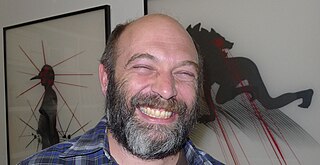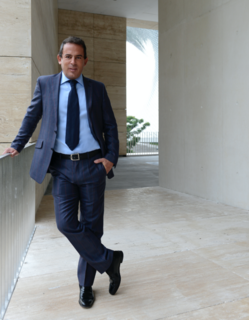
The Solomon R. Guggenheim Museum, often referred to as The Guggenheim, is an art museum located at 1071 Fifth Avenue on the corner of East 89th Street in the Upper East Side neighborhood of Manhattan, New York City. It is the permanent home of a continuously expanding collection of Impressionist, Post-Impressionist, early Modern, and contemporary art and also features special exhibitions throughout the year. The museum was established by the Solomon R. Guggenheim Foundation in 1939 as the Museum of Non-Objective Painting, under the guidance of its first director, Hilla von Rebay. It adopted its current name in 1952, three years after the death of its founder Solomon R. Guggenheim.

The Solomon R. Guggenheim Foundation is a nonprofit organization founded in 1937 by philanthropist Solomon R. Guggenheim and his long-time art advisor, artist Hilla von Rebay. The foundation is a leading institution for the collection, preservation, and research of modern and contemporary art and operates several museums around the world. The first museum established by the foundation was The Museum of Non-Objective Painting, in New York City. This became The Solomon R. Guggenheim Museum in 1952, and the foundation moved the collection into its first permanent museum building, in New York City, in 1959. The foundation next opened the Peggy Guggenheim Collection in Venice, Italy, in 1980. Its international network of museums expanded in 1997 to include the Guggenheim Museum Bilbao in Bilbao, Spain, and it expects to open a new museum, Guggenheim Abu Dhabi, in the United Arab Emirates after its construction is completed.
Museums of modern art listed alphabetically by country.
Carol Bove is an American artist based in New York City. She lives and works in Brooklyn.
Sebastian Diaz Morales is an Argentine visual artist.

Carlos Amorales is a multidisciplinary artist who studied at the Gerrit Rietveld Academy and the Rijksakademie in Amsterdam. The most extensive researches in his work encompass Los Amorales (1996-2001), Liquid Archive (1999-2010), Nuevos Ricos (2004-2009), and a typographic exploration in junction with cinema (2013–present).

Eugenio López Alonso the sole heir to the Jumex fruit-juice fortune, is the President of Fundación Jumex Arte Contemporáneo and a contemporary art collector.

Torolab is an artist collective, workshop and laboratory of contextual studies that identifies situations or phenomena of interest for research, basing the studies in the realm of life styles to better grasp the idea of quality of life. Founded in Tijuana in 1995 by Raúl Cárdenas Osuna.

Darío Escobar is a Guatemalan artist.
Luis Camnitzer is a German-born Uruguayan artist, curator, art critic, and academic who was at the forefront of 1960s Conceptual Art. Camnitzer works primarily in sculpture, printmaking, and installation, exploring topics such as repression, institutional critique, and social justice. For over five decades, his practice has explored the psychological and political dimensions of language.
Arturo Carrera is an Argentine poet born on 27 March 1948 in Coronel Pringles, Buenos Aires Province.

Hélio Oiticica was a Brazilian visual artist, sculptor, painter, performance artist, and theorist, best known for his participation in the Neo-Concrete Movement, for his innovative use of color, and for what he later termed "environmental art", which included Parangolés and Penetrables, like the famous Tropicália. Oiticica was also a filmmaker and writer.

Maman (1999) is a bronze, stainless steel, and marble sculpture by the artist Louise Bourgeois. The sculpture, which depicts a spider, is among the world's largest, measuring over 30 ft high and over 33 ft wide (927 x 891 x 1024 cm). It includes a sac containing 32 marble eggs and its abdomen and thorax are made of ribbed bronze.
Alfredo Da Silva was a painter, graphic artist, and photographer, known for his abstract expressionism. He came to international prominence in 1959 and remained so until his death in 2020.

Liliana Porter is a contemporary artist working in a wide variety of media, including photography, printmaking, painting, drawing, installation, video, theater, and public art.
Leandro Katz is an Argentine-born writer, visual artist and filmmaker known primarily for his films and photographic installations. His works include long-term, multi-media projects that delve into Latin American history through a combination of scholarly research, anthropology, photography, moving images and printed texts.
Patricia Martín Méndez is a curator and art writer. She has conceptualized and directed three of the most relevant contemporary art foundations in Latin America: Colección Jumex, Fundación Alumnos 47 y Fundación Casa Wabi. In addition to creating the infrastructure to operate these institutions, she also served as chief curator, director of acquisitions; and she developed and promoted their educational, sponsorship and scholarship programs.
Miguel Ángel Rojas is a Colombian conceptual artist born in Bogotá in 1946. His work includes drawing, painting, photography, installations and video and is often related to the sexuality, the marginal culture, the violence and problems involved with drug consumption and production.
Adrián Villar Rojas is an Argentinian sculptor known for his elaborate fantastical works which explore notions of the Anthropocene and the end of the world. In his dream like installations he uses aspects of drawing, sculpture, video and music to create immersive situations in which the spectator is confronted with ideas and images of their imminent extinction.

Blanca París de Oddone was a Uruguayan historian and academic, who published extensively on Uruguayan and South American history. She was the winner of a Ford Foundation Fellowship and a Guggenheim Fellowship to further her academic research.









